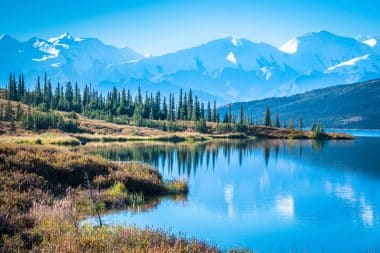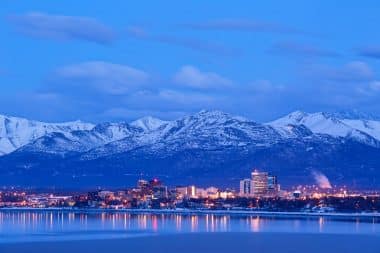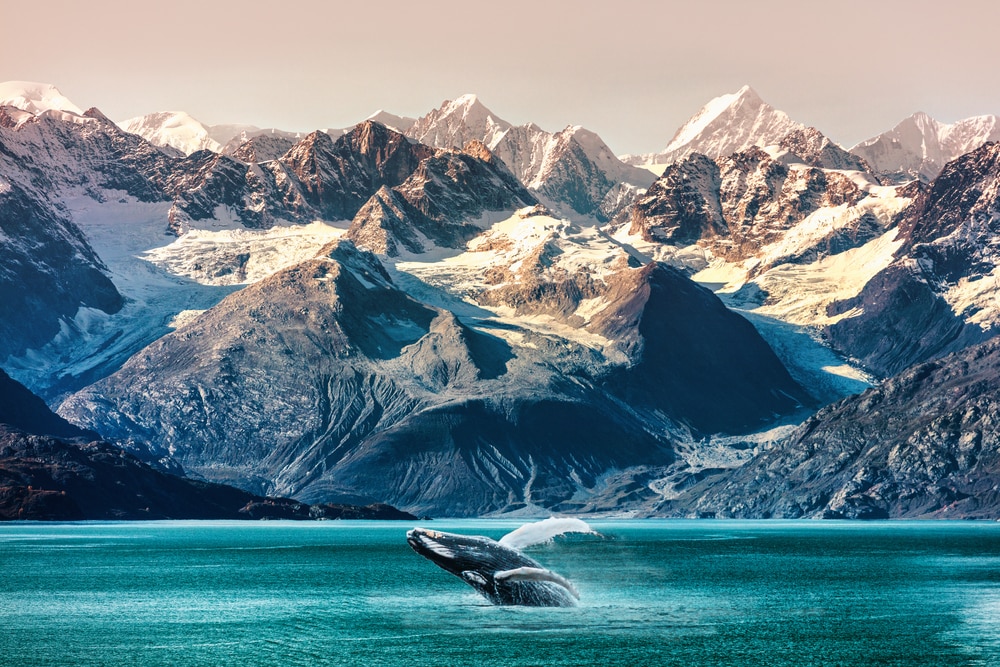In the north of the USA lies a natural paradise that protects much of North America’s fascinating wilderness areas. Untouched snow and ice landscapes as well as exotic flora and fauna unfold in Alaska. Whether whale watching, a road trip on the Alaska Highway or a tour with the Alaska Railroad – anyone who visits the cold north of the USA almost automatically immerses themselves in unforgettable natural worlds. Anchorage, Seward and Juneau offer an insight into everyday life in the country. The sparsely populated and extraordinary natural scenery of gigantic glaciers, the highest mountains in North America and species-rich wilderness has visibly earned the nickname The Last Frontier.
Glaciers, Mountains, Lakes – Natural Alaska
Nothing less than the largest state in the USA unfolds in the northwest of the North American continent, through Canada separated from the rest of Germany: Alaska. Thousands of lakes, about 100,000 glacier-like formations and over 200,000 km² of untouched wild landscapes characterize the extraordinary US state. In total, Alaska protects more than 50 percent of the U.S. protected wilderness. The numerous national parks offer proof – from Denali National Park to Glacier Bay National Park to Wrangell-St. Elias National Park. The latter two are home to internationally recognized UNESCO World Heritage Sites. Such extraordinary landscapes prove: Alaska is a natural paradise in the north of the USA.

Denali National Park in the heart of the country is considered the most visited. Hundreds of thousands of visitors are drawn to the nature reserve, which spreads over more than 19,000 km² every year. Founded in 1917, the park is formed around the eponymous mountain, the highest in North America. 6190 meters above sea level make Denali one of the Seven Summmits, the highest mountains on the continents. Even from a distance, it forms a breathtaking photo motif that symbolizes the untouched and powerful nature of Alaska. Denali National Park unfolds in the northern part of the Alaska Range, which stretches all the way to the Yukon of Canada. The extraordinary natural world is home to wild animals such as grizzly bears, wolves, moose and over 160 bird species, some of which are exotic. The park is strictly protected and can only be reached on selected routes: whether via the George Parks Highway starting in Anchorage or via the Alaska Railroad.
In general, there are few more beautiful ways to explore the heart of Alaska than via the Alaska Railroad. If you want to get to know the region from a different perspective, the famous railway offers a route from Seward via Anchorage to Fairbanks. The scenic route leads through Alaska’s nature and landscapes and offers a comfortable alternative to the road trip. Some of the railway tours also offer integrated sightseeing opportunities. The Alaska Highway also offers a fantastic route, which is considered one of the most beautiful panoramic routes for a road trip in the world. It runs from British Columbia’s Dawsons Creek from Canada through the Yukon to Fairbanks. Long sections of the more than 2,000 km long roads lead through untouched wilderness. If you are planning a scenic road trip through Alaska, you should not miss the route.
Not only in Northern Europe, but also in Alaska, the famous Northern Lights unfold. If you are lucky, you can observe the colorful natural spectacle in national parks such as Denali in appropriate seasons. But the UNESCO World Heritage Site Glacier Bay National Park also provides good reasons for a visit. Highlights are the eponymous glaciers, which attract hundreds of thousands of visitors every year. Guided tours and boat routes take you to the park’s well-known sights, including the edges of some of the approximately 100 glaciers in the designated park area. The Wrangell-St. Elias National Park & Reserve, which is not only the largest national park in the country, but also forms the largest contiguous wilderness area in the USA with more than 3.6 million hectares. It is home to 9 of the 16 highest elevations in the United States – as well as the Kennecott Mines National Historic Landmark, a former copper mine that is now one of Alaska’s tourist attractions.
Anchorage, Seward, Juneau – Alaska from an urban perspective

The capital of Alaska, Juneau, is itself embedded in a scenic nature area. Located on the Gastineau Channel Strait, Glacier Bay National Park is less than 100 km away. About 15 km from the city gates rests the Mendenhall Glacier, which is part of the Juneau Icefield. The Mendenhall Glacier Visitor Center has been set up on site for visitors, which in normal years welcomes about half a million visitors a year – and provides a clear insight into the history of the important glacier. The capital Juneau is home to about 30,000 inhabitants – and is not only a political center of Alaska, but also an important access point to the nature of the US state. Not far away is the natural paradise of Tongass National Forest.
Anchorage is by far the largest settlement in Alaska, home to about 290,000 inhabitants. Anchorage is thus an important cultural and infrastructural center of the country. Here you can visit the Alaska Botanical Garden, the Alaska Zoo and the Anchroage Museum. The latter offers a deeper understanding of Alaska’s land, art, and history. The University of Alaska Museum of the North in Fairbanks, which offers a multifaceted look at Alaska’s rich cultural history, is also one of the country’s renowned museums. The 2,000-inhabitant community of Seward in the south of the country is rather tranquil in comparison, but it is not without reason one of Alaska’s tourist attractions. Located on scenic Resurrection Bay, it stands out as a gateway to Alaska’s nature: whether through local boat and helicopter tours or the popular whale watching from here. Whether Juneau or Seward: The fascinating nature of Alaska is only a few kilometers away.


